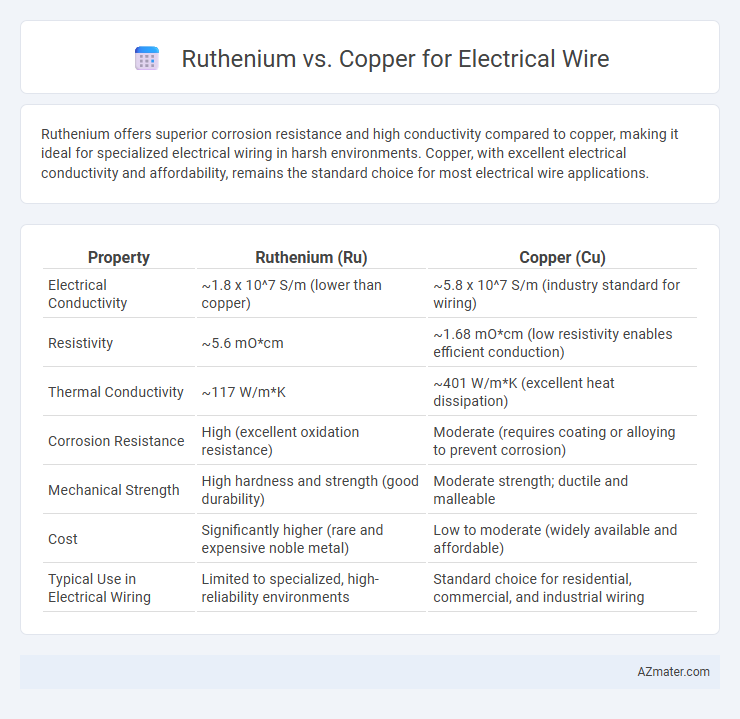Ruthenium offers superior corrosion resistance and high conductivity compared to copper, making it ideal for specialized electrical wiring in harsh environments. Copper, with excellent electrical conductivity and affordability, remains the standard choice for most electrical wire applications.
Table of Comparison
| Property | Ruthenium (Ru) | Copper (Cu) |
|---|---|---|
| Electrical Conductivity | ~1.8 x 10^7 S/m (lower than copper) | ~5.8 x 10^7 S/m (industry standard for wiring) |
| Resistivity | ~5.6 mO*cm | ~1.68 mO*cm (low resistivity enables efficient conduction) |
| Thermal Conductivity | ~117 W/m*K | ~401 W/m*K (excellent heat dissipation) |
| Corrosion Resistance | High (excellent oxidation resistance) | Moderate (requires coating or alloying to prevent corrosion) |
| Mechanical Strength | High hardness and strength (good durability) | Moderate strength; ductile and malleable |
| Cost | Significantly higher (rare and expensive noble metal) | Low to moderate (widely available and affordable) |
| Typical Use in Electrical Wiring | Limited to specialized, high-reliability environments | Standard choice for residential, commercial, and industrial wiring |
Introduction to Ruthenium and Copper in Electrical Applications
Ruthenium and copper are critical metals in electrical applications, with copper being the standard due to its excellent electrical conductivity and affordability. Ruthenium, a rare platinum-group metal, offers superior corrosion resistance and durability, making it valuable in specialized and high-reliability electrical contacts and thin-film resistors. While copper dominates traditional wiring for power distribution, ruthenium enhances performance in niche applications where longevity and resistance to oxidation are essential.
Electrical Conductivity: Ruthenium vs Copper
Copper exhibits superior electrical conductivity, approximately 5.96 x 10^7 S/m at 20degC, making it the industry standard for electrical wiring. Ruthenium, while a valuable noble metal with excellent corrosion resistance, has significantly lower conductivity, around 2.2 x 10^7 S/m, limiting its practical use in conventional electrical wire applications. The disparity in conductivity makes copper the preferred choice for efficient electricity transmission, whereas ruthenium is more suited to specialized contacts and thin film resistors where durability is critical.
Material Properties: Durability and Flexibility
Ruthenium offers exceptional durability with its high resistance to corrosion and oxidation, making it suitable for long-lasting electrical contacts, while copper, though less corrosion-resistant, provides superior flexibility and high electrical conductivity essential for wiring applications. Copper's ductility allows it to be easily bent and shaped without breaking, supporting complex wiring layouts, whereas ruthenium's hardness contributes to its mechanical strength but reduces its flexibility. The trade-off between ruthenium's durability and copper's flexibility influences their specific use in electrical wiring and components where both longevity and adaptability are critical.
Corrosion Resistance Comparison
Ruthenium exhibits superior corrosion resistance compared to copper, making it highly effective in environments where oxidation and chemical degradation are concerns. Copper, while an excellent conductor, is prone to tarnishing and forming oxides that can reduce conductivity over time, especially in humid or acidic conditions. The enhanced stability of ruthenium-coated wires ensures longer lifespan and reliability in harsh electrical applications.
Cost Analysis: Ruthenium vs Copper Wires
Copper wires remain the industry standard due to their low cost and high electrical conductivity, making them economically viable for large-scale electrical applications. Ruthenium, a rare and expensive platinum-group metal, exhibits excellent corrosion resistance and durability but at a significantly higher material cost. The premium price of ruthenium wires limits their use to specialized applications where enhanced performance justifies the increased investment.
Thermal Performance and Heat Dissipation
Ruthenium demonstrates superior thermal performance compared to copper due to its higher melting point of 2,334 degC and excellent resistance to oxidation at elevated temperatures, enhancing heat dissipation in electrical wiring. Copper, with a melting point of 1,085 degC, offers high electrical conductivity but is prone to thermal degradation under extreme heat, limiting its efficiency in high-temperature applications. Ruthenium's stable thermal properties make it ideal for circuits requiring enhanced heat tolerance and prolonged operational lifespan.
Industrial Use Cases and Current Trends
Ruthenium offers superior corrosion resistance and higher hardness compared to copper, making it ideal for specialized industrial applications such as aerospace connectors and high-performance electronic components where durability is critical. Copper remains the dominant material for electrical wiring due to its excellent electrical conductivity, cost-effectiveness, and ease of installation in large-scale industrial and construction projects. Current trends indicate increased exploration of ruthenium-coated copper wires to combine copper's conductivity with ruthenium's surface hardness, enhancing lifespan and performance in harsh environments.
Environmental Impact and Sustainability
Ruthenium, a rare and precious metal, offers superior corrosion resistance and long-term durability, reducing the need for frequent replacements and minimizing electronic waste compared to copper. Copper, while more abundant and highly recyclable, involves energy-intensive mining and refining processes that significantly impact ecosystems and contribute to greenhouse gas emissions. Choosing ruthenium-coated wiring can enhance sustainability by extending wire lifespan and reducing environmental degradation associated with copper extraction and processing.
Recent Innovations in Electrical Wire Materials
Recent innovations in electrical wire materials have spotlighted ruthenium for its superior corrosion resistance and enhanced conductivity compared to copper, leading to increased efficiency in high-performance applications. Ruthenium's exceptional stability at elevated temperatures makes it ideal for wiring in aerospace and advanced electronics, where copper's susceptibility to oxidation limits lifespan. Research advancements in ruthenium nanowires and alloy composites suggest potential breakthroughs in lightweight, durable conductors that outperform traditional copper wiring systems.
Choosing the Right Material for Electrical Wiring
Ruthenium offers superior corrosion resistance and higher conductivity compared to copper, making it a durable option for specialized electrical wiring in harsh environments. Copper remains the preferred choice due to its excellent electrical conductivity, affordability, and ease of installation in most residential and commercial applications. Selecting between ruthenium and copper depends on factors such as environmental conditions, budget constraints, and specific conductivity requirements for the electrical system.

Infographic: Ruthenium vs Copper for Electrical Wire
 azmater.com
azmater.com